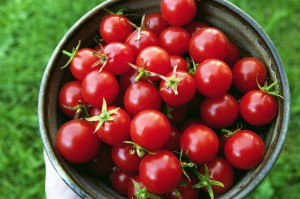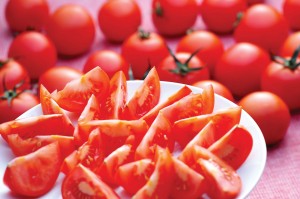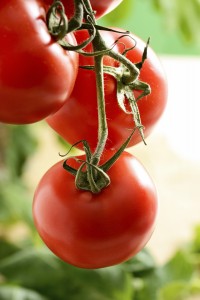 By Tom Snyder | Special to the NB Indy
By Tom Snyder | Special to the NB Indy
Tomatoes are, by far, the most popular home-grown “vegetable” (although it’s really a fruit). Their ubiquity’s not surprising for obvious reasons: they’re very easy to grow, and the flavor of a backyard tomato is sensationally better than store-bought.
Whether you’re a tomato newbie or a hardcore tomatomaniac, there’s always a new variety to try or a new tomato trick. Remember the “upside-down” tomato craze a couple of years ago?
Here’s some juicy insider info that you may not know about tomatoes. A myth or two may be dispelled along the way. These tips are the result of years of growing both heirlooms and hybrids and also from listening to customers—tomato growers love to talk!
Tomato stories are about as tall as fish stories. “The one that got away,” has its tomato equivalent: “A squirrel ate it!”
First, the basics:
Soil: All vegetables give a lot. They produce a lot of foliage as well as fruit, all in a short time. It’s only reasonable that if the soil feeds the plant, then you’ve got to maximize the soil. Amend it well to  conserve water, improve texture and increase nutrient availability. Work in an organic starter fertilizer at the same time.
conserve water, improve texture and increase nutrient availability. Work in an organic starter fertilizer at the same time.
Container Size: If growing in containers, size is important. Most people want to grow tomatoes in too small a pot. A 15-gallon nursery pot is the right size. Not a 5-gallon. Too-small containers cause the watering to be uneven which can cause other problems mentioned below.
Feeding: Tomatoes are not heavy feeders. If you feed too often—even with a food designed specifically for tomatoes—you’ll end up with lush, beautiful plants and little fruit. A light feeding every other month is sufficient.
Watering: Tomatoes need a consistent supply of moisture. They will suffer if you let them go too dry before watering. They can develop blossom-end rot, and will be much more susceptible to diseases. Use an organic mulch to keep the soil evenly moist.
Blossom-end Rot: This is when the bottom of the tomato develops a dark brown patch which begins to rot. A lack of calcium is the cause. However, you don’t need more calcium; you need a consistent supply of moisture. There’s plenty of calcium in California soils, but plants can only take in calcium as it is soluble in water. Uneven watering, insufficient calcium.
 Heirloom or Hybrid? One of the ways of distinguishing the two is that hybrids have been bred for disease-resistance. But here in California, we have an ideal tomato-growing climate and heirlooms rarely get disease! But there’s no question that heirlooms are not as productive. Grow both—heirlooms for their incredible variety of flavor, shape and color, hybrids for production.
Heirloom or Hybrid? One of the ways of distinguishing the two is that hybrids have been bred for disease-resistance. But here in California, we have an ideal tomato-growing climate and heirlooms rarely get disease! But there’s no question that heirlooms are not as productive. Grow both—heirlooms for their incredible variety of flavor, shape and color, hybrids for production.
Tomato Flavors: Yes, there are many, many tomato flavors. Some taste rich and smoky (purples and blacks). Some come already salted (Black Krim and others). Some have a rich, fruity wine taste. Some are super sweet (yellows and oranges—Sungold wins every cherry tomato taste test.) Where will you find all these flavors, and more? From heirlooms. That’s why they’re grown.
Where to Grow Beefsteaks: Beefsteaks are everyone’s dream tomato, but inland gardeners beware: beefsteaks produce little fruit when temperatures are above 85 degrees. If you want a few spectacular tomatoes early in the season and that’s all, grow them. Coastal gardeners: grow beefsteaks.
Pinching or Pruning: Don’t. There’s no need. The technique for removing side shoots was developed in cold-summer, European climates. Removing most of the foliage made it possible for the sun to reach and warm the entire plant. We’ve got plenty of heat and sun in California for tomatoes to produce beautifully without any pinching or pruning. If you do, your fruit may get sunscald.
Don’t Refrigerate: Keep tomatoes at room temperature. Cold temperatures turn the sugars to starch, ruining the home-grown flavor.
Tom Snyder is a California Certified Nursery Professional and the manager of the Armstrong Garden Centers in Newport Beach. Email him your gardening questions to growingdialogue@armstronggarden.com or call (949) 644-9510.




